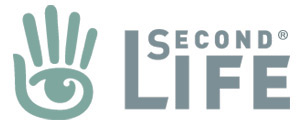A virtual world is a computer-simulated environment intended for users to inhabit and interact via their on-screen representatives known as avatars. Life is represented by three-dimensional graphical representations of multiple users appearing together. The world being simulated has real world rules such as gravity, topography, locomotion, real-time actions, and communication. Second Life is the best known with more than 30 million residents. [Source: Wikipedia,
virtual worlds]
Second Life (SL) is an Internet virtual world started in 2003, developed by Linden Research, Inc (a.k.a. Linden Lab). Membership is free with one advanced level called premium. A downloadable Second Life Viewer enables Residents to interact with each other through avatars, providing an extraordinarily advanced level of social networking combined with general aspects of a metaverse. Residents explore, meet other Residents, socialize, participate in individual and group activities, undertake manufacturing and commercial wholesale and retail activities, create and trade their virtual property and services. Second Life was inspired by the cyberpunk literary movement, notably
Neal Stephenson's novel Snow Crash. Linden Lab's goal is to create a world like the Metaverse described by Stephenson, a user-defined world of general use in which people interact, play, do business, and otherwise communicate. Second Life's virtual currency is the Linden Dollar (Linden, or L$). It is
exchangeable for US Dollars in a marketplace consisting of residents, Linden Lab and real life companies. Second Life is not a game.. It does NOT have points, scores, winners or losers, levels, an end-strategy, or most of the other characteristics of games. It is a semi-structured virtual environment where characters undertake activities for the purpose of personal enjoyment. More than 10 million accounts have been registered. [Source: Wikipedia,
Second Life]
The basic membership is free. With it, you can do virtually everything people do in Second Life.
To have the best experience, check out the
System Requirements page to make sure your computer can run the Second Life viewer.
Next, sign up for a
Second Life account. Your first basic account is free. You don't have to give them a credit card number, unless you wish to. You will have to give Linden Lab some information so they can verify that you are beyond your 18th birthday if you wish to enter the adult main grid.
You will select a last name for your avatar from a list provided by Linden Lab. Then you will make up your own first name. Be sure to choose first and last names you can be proud of because the name you choose now is the name you will have in-world. You can't change it later.
Next, download and install the
Second Life viewer. Run the viewer to start exploring the Second Life world
When you log in to Second Life for the first time, you will land on
Orientation Island. It is designed to guide new residents -– called newbies -– through Second Life's controls and features. If you spend time on Orientation Island and, also, Help Island learning how to navigate and use Second Life, you'll have a much more rewarding experience later. If you would like to return at any time after you leave Orientation Island, you may. In that event, you would visit the
Public Orientation Island or the
Public Help Island. Public Orientation Island and the Public Help Island are identical to the Orientation Island and Help Island you saw during your first login. However. they're open to the public.
If you get lost or confused while navigating around Second Life, ask someone for help. Experienced residents are happy to help new arrivals. After all, everybody has needed help at some time or another.
Second Life is a world for persons age 18 and up. People under 18 use a separate Teen Second Life world. Land in SL is marked either PG or Mature. In Second Life, those ratings are like the ratings used by the movie and television industries to denote the age-appropriateness of behavior, language and creations. PG areas are free from sexually explicit language or behavior, swearing and other forms of aggressive language, violent behavior and imagery, including horror. There are PG areas in Second Life because adults often seek an experience free of Mature content. PG regions are areas where you're free to say and do things that you would feel comfortable doing in front of your grandmother or a grade school class. MATURE areas are limited to the adult-accessible areas of Second Life only. They do allow adult language and behavior. Residents are free to engage in more adult activity and language. Of course, explicit adult content must be contained behind "closed doors" in private. Explicit adult language should be in Instant Message (IM) and not in open chat. If you decide whether your activity or content is allowed in a PG region, then it's best kept to a Mature region.
